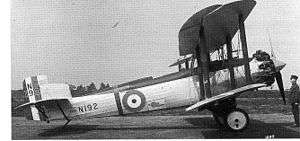Fairey Ferret
| Ferret | |
|---|---|
 | |
| Ferret Mk.III | |
| Role | Two-seat general-purpose biplane |
| National origin | United Kingdom |
| Manufacturer | Fairey Aviation Company |
| First flight | June 1925 |
| Number built | 3 |
|
| |
The Fairey Ferret was a 1930s British general-purpose biplane designed and built by the Fairey Aviation Company.[1] It performed well in trials but was not ordered into production.[1]
Development
The Ferret was designed to meet a Fleet Air Arm requirement defined by specification 37/22[2] for a reconnaissance aircraft; it was the company's first all-metal design.[1] With a lack of interest from the FAA the company proposed the design to meet a Royal Air Force requirement for a general-purpose biplane.[1]
The company built three prototypes, two were three-seaters (to meet the naval requirement) and the third was a two-seater.[1] The two-seater Ferret III was also fitted with a new Fairey-designed high-speed gun mounting in the rear cockpit.[1] The first prototype first flew in June 1925 powered by a 400 hp (298 kW) Armstrong Siddeley Jaguar IV radial engine.[1] The other two aircraft had a nine-inch extension to the wingspan and both were fitted with a 425 hp (317 kW) Bristol Jupiter radial engine.[1]
The aircraft performed well during trials at RAF Martlesham Heath but was not ordered into production.[1]
Variants

- Ferret Mk I
- Three-seat prototype powered by a 400hp (298kW) Armstrong Siddeley Jaguar IVl radial engine, one built.[1]
- Ferret Mk II
- Three-seat prototype powered by a 425hp (317kW) Bristol Jupiter radial engine, one built.[1]
- Ferret Mk III
- Two-seat prototype powered by a 425hp (317kW) Bristol Jupiter radial engine, one built.[1]
Specifications (Ferret III)
Data from [1]
General characteristics
- Crew: two
- Length: 29 ft 6 in (8.99 m)
- Wingspan: 40 ft 7 in (12.37 m)
- Height: 10 ft 3 in (3.12 m)
- Wing area: 380 ft2 (35.30 m2)
- Empty weight: 2,583 lb (1,172 kg)
- Gross weight: 4,765 lb (2,161 kg)
- Powerplant: 1 × Bristol Jupiter VI 9-cylinder radial engine, 425 hp (317 kW)
Performance
- Maximum speed: at 5,000 ft (1,524 m)135 mph (217 km/h)
- Service ceiling: 15,500 ft (4,725 m)
- Rate of climb: [2] initial 920 ft/min (4.67 m/s)
Armament
- 1 × fixed forward-firing 0.303in (7.7mm) Vickers machine-gun (on starboard side of fuselage)
- 1 × 0.303in (7.7mm) Lewis machine-gun in rear cockpit
- Up to 500lb (227kg) bombs fitted under wings
References
| Wikimedia Commons has media related to Fairey Ferret. |
Notes
Bibliography
- The Illustrated Encyclopedia of Aircraft (Part Work 1982-1985). Orbis Publishing.
- Taylor, H.A. (1974). Fairey Aircraft since 1915. London: Putnam Publishing. ISBN 0-370-00065-X.